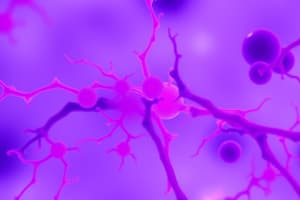Podcast
Questions and Answers
What is the study of disease known as?
What is the study of disease known as?
What are the causes of diseases known as?
What are the causes of diseases known as?
What is the macroscopic appearance of structural alterations caused by a disease called?
What is the macroscopic appearance of structural alterations caused by a disease called?
What are the changes seen by an armed eye called?
What are the changes seen by an armed eye called?
Signup and view all the answers
What type of metaplasia is associated with Barrett esophagus?
What type of metaplasia is associated with Barrett esophagus?
Signup and view all the answers
What is the consequence of urolithiasis leading to obstruction of urinary flow?
What is the consequence of urolithiasis leading to obstruction of urinary flow?
Signup and view all the answers
Which condition is characterized by severe caloric deficiency and generalized atrophy?
Which condition is characterized by severe caloric deficiency and generalized atrophy?
Signup and view all the answers
What is the consequence of denervation due to peripheral nerve damage?
What is the consequence of denervation due to peripheral nerve damage?
Signup and view all the answers
What is the purpose of metaplasia?
What is the purpose of metaplasia?
Signup and view all the answers
What is the consequence of raised intracranial pressure due to hydrocephalus?
What is the consequence of raised intracranial pressure due to hydrocephalus?
Signup and view all the answers
What type of atrophy is associated with severe protein-caloric deficiency and hypoalbuminemia?
What type of atrophy is associated with severe protein-caloric deficiency and hypoalbuminemia?
Signup and view all the answers
What is the consequence of immobilization following a bone fracture?
What is the consequence of immobilization following a bone fracture?
Signup and view all the answers
Which cellular response involves a decrease in cell size or number?
Which cellular response involves a decrease in cell size or number?
Signup and view all the answers
What type of cells have varying mitotic activity and adaptive potential?
What type of cells have varying mitotic activity and adaptive potential?
Signup and view all the answers
Which type of hypertrophy occurs in the skeletal muscles of athletes?
Which type of hypertrophy occurs in the skeletal muscles of athletes?
Signup and view all the answers
What can result from excessive hormonal stimulation or viral infections?
What can result from excessive hormonal stimulation or viral infections?
Signup and view all the answers
Which response involves an increase in cell size?
Which response involves an increase in cell size?
Signup and view all the answers
What is an example of pathologic hypertrophy?
What is an example of pathologic hypertrophy?
Signup and view all the answers
What type of hyperplasia can be hormone-induced, like in the female breast during pregnancy?
What type of hyperplasia can be hormone-induced, like in the female breast during pregnancy?
Signup and view all the answers
What involves the activation of transcription factors and signaling pathways?
What involves the activation of transcription factors and signaling pathways?
Signup and view all the answers
When does atrophy occur in response to decreased protein synthesis, increased degradation, or chronic ischemia?
When does atrophy occur in response to decreased protein synthesis, increased degradation, or chronic ischemia?
Signup and view all the answers
What is an example of physiologic hypertrophy?
What is an example of physiologic hypertrophy?
Signup and view all the answers
Which type of cells have low mitotic activity but can regenerate under appropriate conditions?
Which type of cells have low mitotic activity but can regenerate under appropriate conditions?
Signup and view all the answers
What type of adaptive response includes distinct characteristics and examples like hypertrophy, hyperplasia, atrophy, and metaplasia?
What type of adaptive response includes distinct characteristics and examples like hypertrophy, hyperplasia, atrophy, and metaplasia?
Signup and view all the answers
Study Notes
Cellular Response to Stress and Adaptive Potential
- The content and learning objectives focus on the cellular response to stress and the characteristics of adaptive responses.
- Cells maintain homeostasis and can undergo adaptation or injury when exposed to stimuli.
- Adaptive responses include hypertrophy, hyperplasia, atrophy, and metaplasia, each with distinct characteristics and examples.
- Different cell types have varying mitotic activity and adaptive potential, classified as labile, stable, or permanent cells.
- Hypertrophy involves an increase in cell size, while hyperplasia involves an increase in cell number, occurring in different cell types.
- Physiologic hypertrophy can result from increased mechanical demand, such as in skeletal muscles of athletes or the myocardium during pregnancy.
- Pathologic hypertrophy occurs due to increased mechanical demand from pathological processes, like in the myocardium during hypertension.
- Mechanisms of mechanical-demand-induced hypertrophy involve the activation of transcription factors and signaling pathways.
- Physiologic hyperplasia can be hormone-induced, like in the female breast during pregnancy, while pathologic hyperplasia can result from excessive hormonal stimulation or viral infections.
- Atrophy involves a decrease in cell size or number and occurs in response to decreased protein synthesis, increased degradation, or chronic ischemia.
- Examples of atrophy include embryonic structures during fetal development, myometrium after delivery, and organ atrophy due to chronic ischemia or metabolic abnormalities.
- Overall, the content provides a detailed understanding of the cellular response to stress and the various adaptive responses in different cell types.
Studying That Suits You
Use AI to generate personalized quizzes and flashcards to suit your learning preferences.
Related Documents
Description
Test your knowledge of the cellular response to stress and adaptive potential with this quiz. Explore concepts such as hypertrophy, hyperplasia, atrophy, and metaplasia, and learn about the characteristics and examples of these adaptive responses in different cell types. Understand the mechanisms and factors influencing cellular adaptation and injury when exposed to stimuli, and gain insights into the mitotic activity and adaptive potential of labile, stable, and permanent cells.




